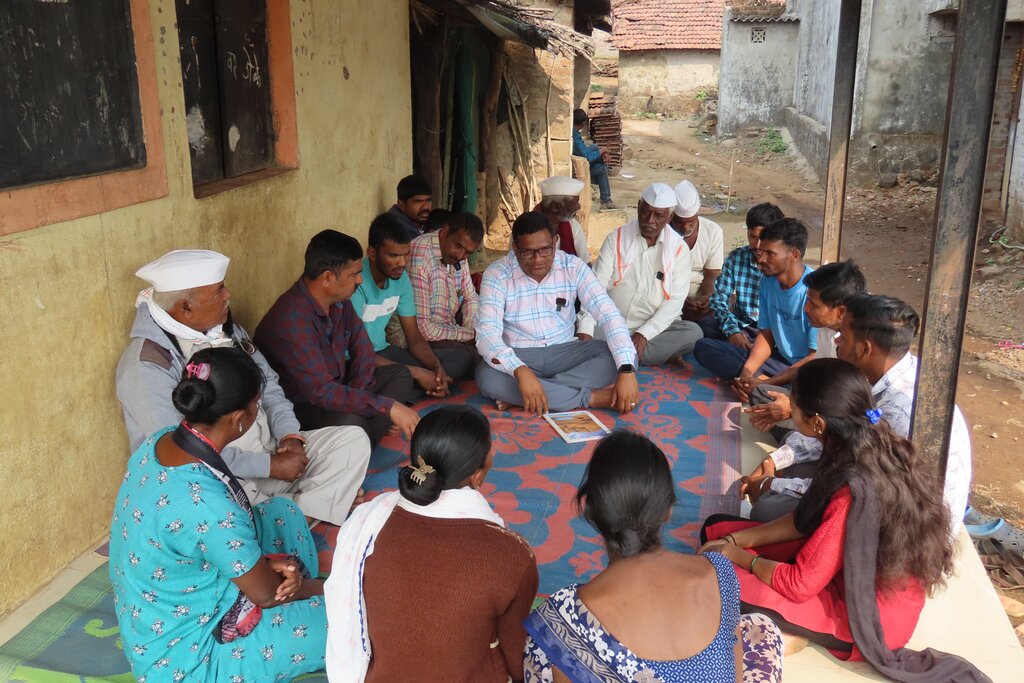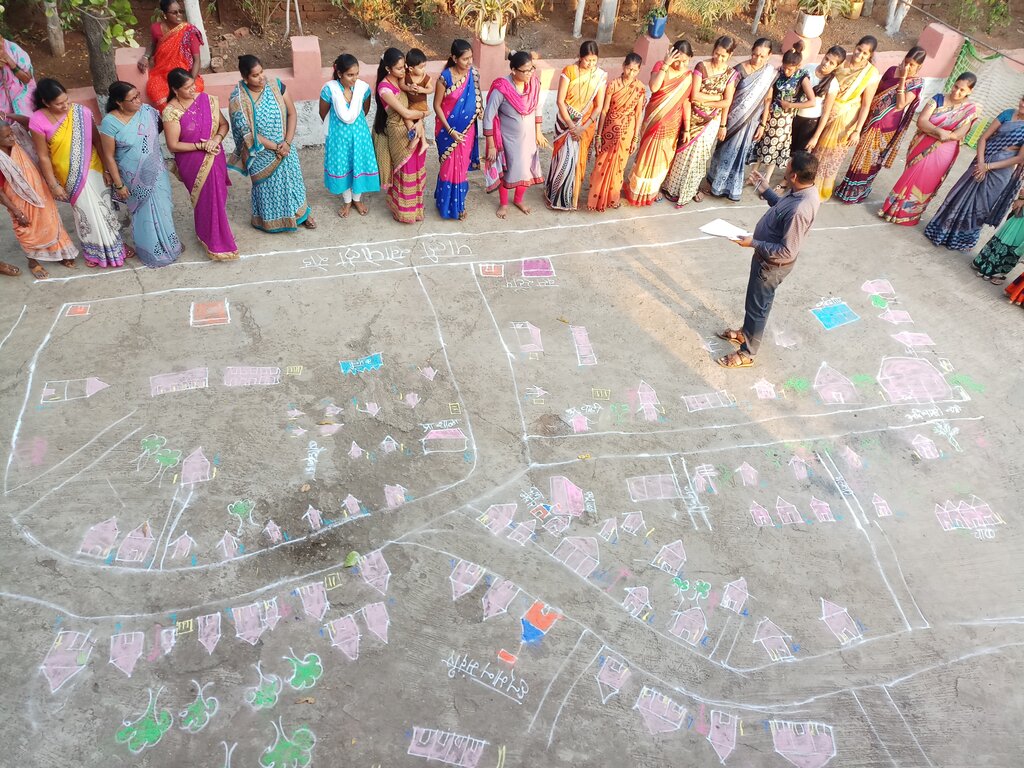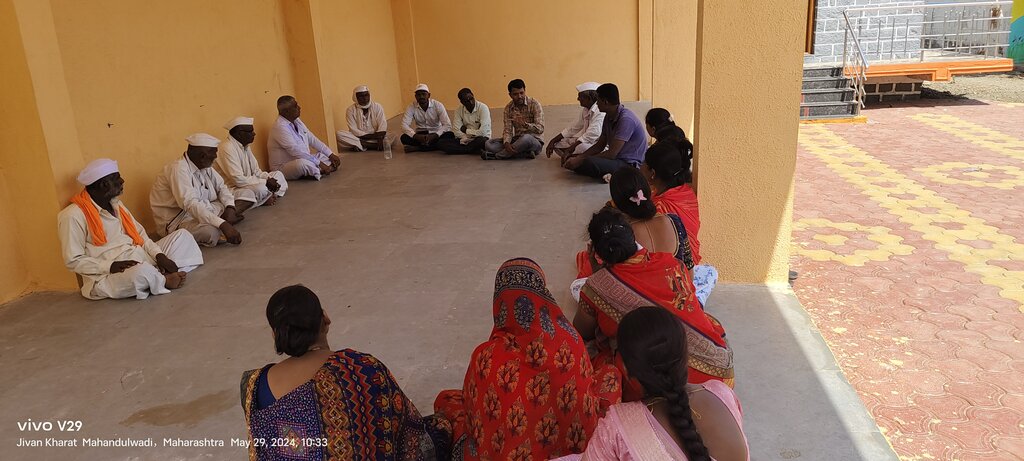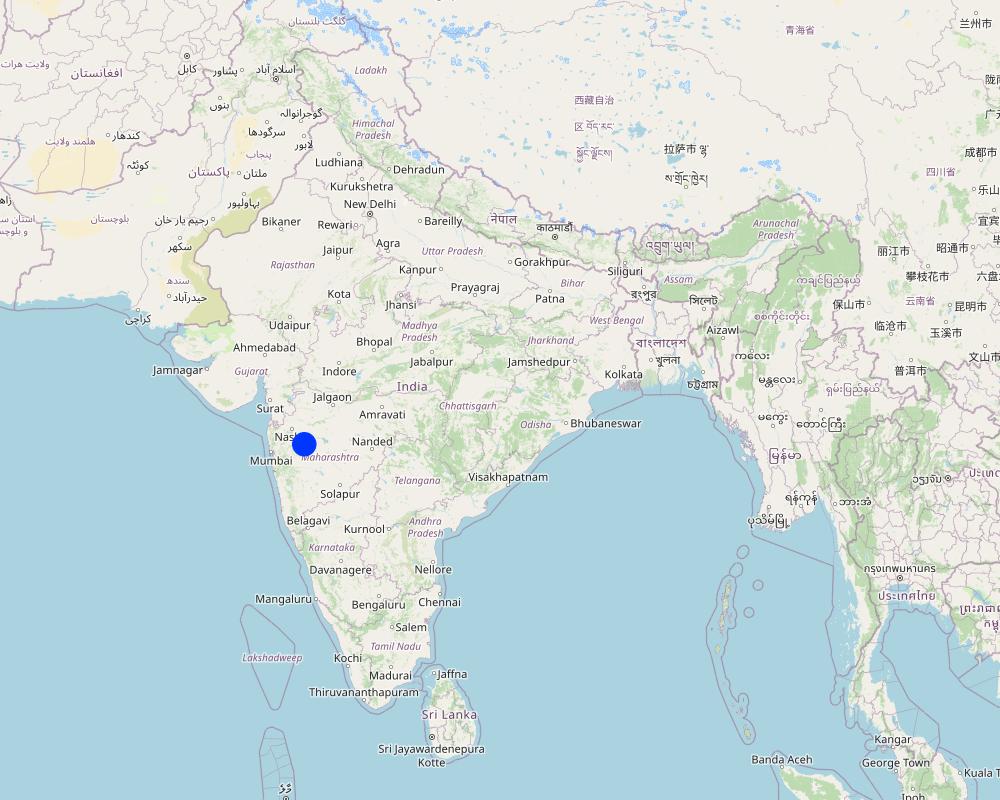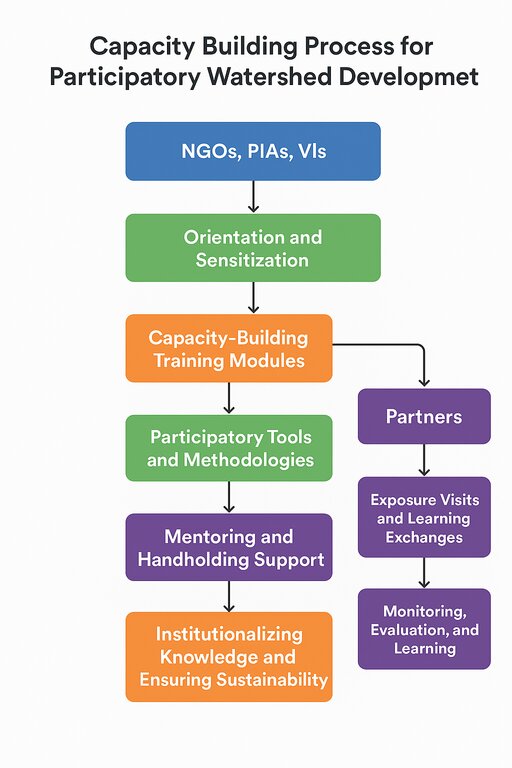Capacity Building Process for Participatory Watershed Development [印度]
- 创建:
- 更新:
- 编制者: Arun Bhagat
- 编辑者: –
- 审查者: Udo Höggel
Community Participation in Participatory Watershed Development
approaches_7656 - 印度
查看章节
全部展开 全部收起1. 一般信息
1.2 参与方法评估和文件编制的资源人员和机构的联系方式
关键资源人员
SLM专业人员:
Rajapure Ganesh
+91 9422226412
ganesh.rajapure@wotr.org.in
Watershed Organisation Trust (WOTR)
Paryavaran Sarasnagar Road, Behind, Market Yard Road, Ahilyanagar, Maharashtra 414001
印度
SLM专业人员:
D’Souza Marcella
+91 9422226415
marcella.dsouza@gmail.com
W-CReS (the WOTR Centre for Resilience Studies), Watershed Organisation Trust (WOTR), Pune
The Forum, 2nd Floor, Pune - Satara Rd, above Ranka Jewellers, Padmavati Nagar, Corner, Maharashtra 411009
印度
SLM专业人员:
SLM专业人员:
Dadas Dada
+91 9892763960
dada.dadas@wotr.org.in
W-CReS (the WOTR Centre for Resilience Studies), Watershed Organisation Trust (WOTR), Pune
The Forum, 2nd Floor, Pune - Satara Rd, above Ranka Jewellers, Padmavati Nagar, Corner, Maharashtra 411009
印度
SLM专业人员:
Khedkar Vishnu
+91 7798818283
vishnu.khedkar@wotr.org.in
W-CReS (the WOTR Centre for Resilience Studies), Watershed Organisation Trust (WOTR), Pune
The Forum, 2nd Floor, Pune - Satara Rd, above Ranka Jewellers, Padmavati Nagar, Corner, Maharashtra 411009
印度
有助于对方法进行记录/评估的机构名称(如相关)
Watershed Organisation Trust (WOTR) - 印度1.3 关于使用通过WOCAT记录的数据的条件
(现场)数据是什么时候汇编的?:
24/09/2025
编制者和关键资源人员接受有关使用通过WOCAT记录数据的条件。:
是
2. SLM方法的描述
2.1 该方法的简要说明
The Capacity Building Process for Participatory Watershed Development is a structured approach to strengthen the technical, managerial, and social skills of Non-Governmental Organizations (NGOs), Partner Implementation Agencies (PIAs), and Village-level Institutions (VIs). It includes orientation, training, participatory tools, mentoring, exposure visits, monitoring, and institutionalization. The process enhances competencies, fosters creativity and confidence, promotes community ownership, and ensures effective, sustainable planning, implementation, and management of watershed-based natural resource management and climate-resilient interventions.
2.2 该方法的详细说明
该方法的详细说明:
Capacity Building Process for Participatory Watershed Development:
Many Non-Governmental Organizations (NGOs), Partner Implementation Agencies (PIAs), and Village-level Institutions (VIs) aspire to implement participatory natural resource management (NRM) using a watershed approach. However, they often lack the technical expertise, practical skills, and experience needed for effective implementation. To address this gap, a structured capacity-building and induction strategy is essential. Such a strategy strengthen the technical and managerial competencies, nurtures creativity, and enhances their confidence to plan, implement, and sustain watershed interventions. In turn, it transforms their approach to resource mobilization, management, and sustainability. A common environmental challenge—such as water scarcity, land degradation, and climate change—creates opportunities to unite communities around shared needs. The Watershed Organisation Trust (WOTR) has effectively used watershed development as a unifying framework to bring people together, encouraging collective action for improving livelihoods and building resilience—especially among the poor and vulnerable.
Purpose of Capacity Building:
The overarching goal of the capacity-building process is to develop the knowledge, skills, attitudes, and confidence of NGOs, PIAs, and VIs in designing, implementing, and sustaining participatory, watershed-based NRM and climate-resilient development interventions.
Expected Outcomes:
•Improved competence in managing watershed-based NRM and climate change adaptation.
•Strengthened community ownership and participation.
•Effective and sustainable implementation of interventions.
•Positive transformation in approaches to resource mobilization and local governance.
Methodology and Key Steps:
The capacity-building approach comprises a series of interlinked steps, each reinforcing the others. Together, they form a comprehensive and adaptive learning process.
Step 1: Orientation and Sensitization
Objective: Build a common understanding and motivation among all project stakeholders.
Approach:
•Conduct orientation sessions explaining linkages between natural resources, livelihoods, and resilience.
•Share success stories and best practices to inspire commitment.
•Define roles and responsibilities of community-based organizations and NGOs.
Step 2: Capacity-Building Training Modules
Objective: Strengthen technical and managerial skills, especially among field-level stakeholders.
Core Modules:
•Technical Skills: Soil and water conservation, water budgeting, sustainable agriculture, climate resilience, and ecosystem-based adaptation.
•Social & Institutional Development: Social mobilization, gender inclusion, facilitation, group dynamics, and strengthening local institutions.
•Project Management: Planning, budgeting, reporting, and monitoring for effective implementation.
Step 3: Participatory Tools and Methodologies
Objective: Equip local groups with practical tools for participatory planning and action.
Tools and Methods:
•Participatory Rural Appraisal (PRA) tools such as resource mapping, seasonal calendars, and wealth ranking.
•Participatory Net Planning (PNP) for micro-level watershed planning.
•Use of digital tools and simple MIS platforms for data management and progress tracking.
Step 4: Mentoring and Handholding Support
Objective: Ensure continued learning, quality implementation, and motivation.
Approach:
•On-site technical and managerial guidance by experienced facilitators or resource NGOs.
•Regular review and feedback meetings to troubleshoot challenges.
•Peer learning and cross-visits among different project sites for shared learning.
Step 5: Exposure Visits and Learning Exchanges
Objective: Promote experiential and peer-to-peer learning.
Approach:
•Organize visits to successful watershed and NRM sites.
•Facilitate interactions with experienced community institutions and farmer groups.
•Encourage farmer-to-farmer extension to build local confidence and innovation.
Step 6: Monitoring, Evaluation, and Learning (MEL)
Objective: Foster accountability, reflection, and adaptive learning.
Approach:
•Train partners in participatory monitoring, data collection, documentation, and reporting.
•Develop and use simple, participatory monitoring tools to track outcomes and learning.
•WOTR’s existing participatory MEL tools are adapted for partners to ensure consistent data and insights.
Step 7: Institutionalizing Knowledge and Ensuring Sustainability
Objective: Build long-term local ownership and reduce dependence on external support.
Approach:
•Develop local resource persons, for example para-professionals.
•Establish local training and resource centers for continuous on-the-ground support.
•Document best practices, lessons learned, and local innovations for knowledge sharing.
•Gradually transfer leadership and responsibility to community institutions.
2.3 该方法的照片
关于照片的一般说明:
Photos of activities like resource mapping are important as they visually document community participation, local knowledge, and the planning process. They help capture the involvement of villagers, the use of PRA tools, and the mapping outcomes. Such photos serve as powerful evidence of participatory planning, support monitoring and reporting, and effectively communicate project processes and impacts to stakeholders and partners.
2.5 采用该方法的国家/地区/地点
国家:
印度
区域/州/省:
Maharashtra, MadhyaPradesh, Telangana, Karnataka, Jharkhand, Odisha, Chhattisgarh states
有关地点的进一步说明:
Ahilyanagar, Jalna, Hyderabad, Sanga Reddy, Mandala, Gajapati, Rayagada, and more, etc.
注释:
Watershed Organisation Trust (WOTR), established in 1993, has been actively engaged in capacity building since its inception (Stared from this location). This participatory approach continues to be implemented in WOTR-supported villages across nine states in India.
Map
×2.6 该方法的开始和终止日期
若不知道准确的年份,请注明该方法的大致开始日期。:
10-50年前
注释:
Year of termination is not applicable because capacity building is essential in participatory watershed management.
2.7 方法的类型
- The capacity-building process (approach) combines traditional and indigenous knowledge, recent local innovations, and project or program-based approaches for effective and sustainable watershed management.
2.8 该方法的主要目的/目标
The main aims/objectives of the Capacity Building Process for Participatory Watershed Development are
• Strengthen technical, social, and managerial skills of NGOs, PIAs, and Village-level Institutions for effective watershed management.
• Promote participatory planning, community ownership, and active engagement in watershed interventions.
• Build project management capacity, including planning, budgeting, monitoring, and reporting.
• Support continuous learning through mentoring, exposure visits, and peer exchanges.
• Ensure sustainability by institutionalizing knowledge, developing local resource persons, and transferring leadership to communities.
2.9 推动或妨碍实施本办法所适用的技术的条件
社会/文化/宗教规范和价值观
- 启动
Living together for a common purpose forms the foundation of society. A strong sense of ownership and active participation is essential for achieving sustainable development.
财务资源和服务的可用性/可得性
- 启动
Transparency acts as a social audit, it serves as an effective tool for accountability and openness.
机构设置
- 启动
It provides a platform for community members to develop and exercise leadership.
参与者的的协作/协调
- 启动
It forms the foundation for building strong and sustainable institutions.
- 阻碍
Conflicts may arise among community members due to differing opinions, taboos, or perceptions.
法律框架(土地使用权、土地和水使用权)
- 启动
Village-level Institutions (VIs) are linked with the local governing body, i.e., the Village Panchayat.
政策
- 启动
It facilitates the process of social auditing.
土地治理(决策、实施和执行)
- 启动
It enhances community participation in planning and implementation.
了解SLM,获得技术支持
- 启动
Through training that provides technical knowledge on the project’s key components.
市场(购买投入,销售产品)和价格
- 启动
Training materials can be procured.
工作量、人力资源可用性
- 启动
Provides local animators to assist in project implementation.
3. 相关利益相关者的参与和角色
3.1 该方法涉及的利益相关者及其职责
- 当地土地使用者/当地社区
Farmers, Women, and Youth
Consent to work, willingness to participate in mobilization activities, and attendance at capacity-building events.
- 社区组织
Men, Women, and Local Representatives
Making informed decisions and managing conflicts effectively. Encouraging active community participation, carefully selecting beneficiaries, and monitoring the impacts of interventions.
- SLM专家/农业顾问
NGO staff and team members
Planning, implementing, and monitoring activities
- 研究人员
Researchers and community members (men and women) involved in planning, implementation, and impact monitoring
Researchers design and guide training activities, facilitate knowledge sharing, provide technical expertise, monitor progress, and assess the impact of interventions to strengthen the skills and capacities of communities and stakeholders.
- 教师/学龄儿童/学生
School and nursery teachers.
Facilitating learning, guiding children, and supporting community education initiatives
- NGO
Board members
Board resolution
- 私营部门
Technical Expert - Individual or Group
Support to the SLM specialist
- 地方政府
Gram Panchayat (PRI)
Local governance body
Necessary resolutions
- 国家政府(规划者、决策者)
Concern Departments
Content and Guidelines for Capacity-Building Efforts
- 国际组织
Donor Agencies
Content and Guidelines for Capacity-Building Efforts
Funding, technical support, and guidance for community development and capacity-building initiatives
如果涉及多个利益相关者,请注明领导机构:
The main implementing agency will take the lead role in planning, coordinating, and executing the activities (Capacity-building processes are closely linked to project implementation, so the project’s nodal agency takes the lead role).
3.2 当地土地使用者/当地社区参与该方法的不同阶段
| 当地土地使用者/当地社区的参与 | 指定参与人员并描述活动 | |
|---|---|---|
| 启动/动机 | 自我动员 | Community members need to demonstrate their willingness to actively participate in project planning and implementation. |
| 计划 | 互动 | Farmers, CBO (Community-Based Organisation) members, women, and village-level animators actively participate in planning and review meetings, and contribute by passing resolutions in CBO meetings. |
| 实施 | 互动 | Farmers, CBO members, women, and the project team actively participate in executing activities and in collecting relevant contributions. |
| 监测/评估 | 互动 | CBO members participate in joint monitoring visits and share information for impact documentation and research studies. |
| 互动 |
3.3 流程图(如可用)
具体说明:
This visual is illustrating a Capacity Building Process for Participatory Watershed Development using a step-by-step flowchart.
It starts with key implementing institutions such as NGOs, PIAs, and Village Institutions (VIs). The process begins with Orientation and Sensitization, followed by Capacity-Building Training Modules that strengthen skills and technical knowledge. From here, the approach branches into two parallel components:
1. Participatory Tools and Methodologies → enabling communities to actively take part in planning and decision-making.
2. Partners → supporting collaboration through exposure visits and knowledge sharing.
The next stage provides Mentoring and Handholding Support to guide field-level implementation.
Finally, the process moves to Institutionalizing Knowledge and Ensuring Sustainability, ensuring that skills, systems, and learnings remain within the community for long-term development impact. Overall, the diagram shows a structured learning pathway that builds capacity, supports practical application, and ensures sustainable watershed management.
作者:
Dr. Arun Bhagat
3.4 有关SLM技术选择的决策
具体说明谁有权决定选择要实施的技术:
- 所有相关参与者,作为参与式方法的一部分
解释:
The NGO plays a leading role in initiating the process, while community members become actively involved as the process progresses.
明确做出决策的依据:
- 对充分记录的SLM知识进行评估(基于证据的决策)
4. 技术支持、能力建设和知识管理
4.1 能力建设/培训
是否为土地使用者/其他利益相关者提供培训?:
是
明确受训人员:
- 土地使用者
- 现场工作人员/顾问
如果相关,请说明性别、年龄、地位、种族等。:
Community members of all age groups.
培训形式:
- 在职
- 农民对农民
- 示范区域
- 公开会议
涵盖的主题:
Key concepts and topics include: Environmental degradation, Natural Resource Management, Watershed Development, Participatory planning and monitoring tools, Community participation and contributions, Role of stakeholders, Portfolio management, Women empowerment, Gender inclusion, Sustainable agriculture, and Post-project management.
注释:
Training modules are designed to meet the specific needs of the project and location.
4.2 咨询服务
土地使用者有权使用咨询服务吗?:
是
指明是否提供了咨询服务:
- 在土地使用者的土地上
说明/注释:
In today’s era of climate change and volatile markets, Indian farmers face growing challenges that affect productivity and food security. Unlike urban areas that benefit from the digital revolution, rural farmers need timely, localized, and actionable information on sustainable farming practices. WOTR’s FarmPrecise app addresses this need, providing a comprehensive, data-driven tool to support informed agricultural decisions. Previously, WOTR developed an Agromet Advisory System delivering crop- and location-specific advisories via SMS using data from the India Meteorological Department (IMD). While valuable for weather forecasts, this system lacked personalization and direct farmer engagement.
WOTR launched the FarmPrecise app in 2019 to provide dynamic, farm-specific advisories. Since then, it has grown substantially, with over 1 lakh downloads, covering 30 crops across the Indian States of Maharashtra, Telangana, Odisha, and Madhya Pradesh, and is available in five languages: English, Hindi, Marathi, Telugu, and Odia.
4.3 机构强化(组织发展)
是否通过这种方法建立或加强了机构?:
- 是,非常
具体说明机构的强化或建立程度:
- 本地
说明机构、角色和职责、成员等。:
Village Development Committee (VDC): Responsible for planning and executing project activities, selecting beneficiaries and work sites, managing conflicts, overseeing community contributions, ensuring quality supervision and monitoring, maintaining records, and conducting social audits.
Self-Help Groups (SHGs): Organize women into savings and credit groups and manage SHG operations.
Village Water Management Team: Promote water budgeting, coordinate water governance, and support sustainable water management practices.
具体说明支持类型:
- 能力建设/培训
提供进一步细节:
Capacity-building inputs are delivered in a sequence of trainings aligned with the project cycle tenure.
4.4 监测和评估
监测和评估是该方法的一部分吗?:
是
注释:
In regular Community-Based Organization (CBO) trainings, the monitoring component is a key focus area.
若是,该文件是否用于监测和评估?:
是
注释:
It is used for follow-up purposes as well as for knowledge dissemination.
4.5 研究
研究是该方法的一部分吗?
是
明确话题:
- 社会学
- 经济/市场营销
- 生态学
- 技术
提供进一步的细节,并指出是谁做的研究:
The baseline survey tool is used for impact documentation. It helps reach beneficiaries to record their quality of life and assess the effects of project activities.
5. 融资和外部物质支持
5.1 该方法中SLM组成部分的年度预算
如果不知道准确的年度预算,请给出一个范围:
- < 2,000
注释(例如主要的资助来源/主要捐助者):
Main sources of funding / major donors: National and international donors, and Corporate Social Responsibility (CSR) contributions.
5.2 为土地使用者提供财政/物质支援
土地使用者是否获得实施该技术的财政/物质支持?:
是
如果是,请具体说明支持的类型、条件和提供者:
Although not through direct financial or material support, land users (community) benefit from improved skills and knowledge, and gain advantages through active participation and involvement.
5.3 对特定投入的补贴(包括劳动力)
- 无
如果土地使用者的劳动力是一项重要的投入,那么是不是:
- 自愿
注释:
While labor is not required, participation of land users in the capacity-building process is essential. Landowners contribute their knowledge and time to share ideas and insights.
5.4 信用
是否根据SLM活动的方法给予信用值?:
否
5.5 其它激励或手段
是否有其他激励措施或工具用于促进SLM技术的实施?:
否
6. 影响分析和结论性陈述
6.1 方法的影响
该方法是否有助于当地土地使用者,提高利益相关者的参与度?:
- 否
- 是,很少
- 是,中等
- 是,支持力度很大
Greater awareness and better understanding of project management and its impact on project components led to higher participation
这种方法是否有助于基于证据的决策?:
- 否
- 是,很少
- 是,中等
- 是,支持力度很大
The progress of project components is presented in common meetings, such as Gram Sabhas, enabling CBO members to make informed decisions.
该方法是否帮助土地使用者实施和维护SLM技术?:
- 否
- 是,很少
- 是,中等
- 是,支持力度很大
Active and well-informed participation in planning, execution, and ensuring quality work.
该方法是否提高了SLM的协调性和成本效益?:
- 否
- 是,很少
- 是,中等
- 是,支持力度很大
Capacity building produces synergistic outcomes.
该方法是否调动/改善了使用财务资源实施SLM的途径?:
- 否
- 是,很少
- 是,中等
- 是,支持力度很大
The participatory Net Planning (PNP) tool in support of capacity building approach facilitates proper land-use planning with budget allocation for specific plots.
该方法是否提高了土地使用者实施土地管理的知识和能力?:
- 否
- 是,很少
- 是,中等
- 是,支持力度很大
Capacity building activities and net planning exercises provide inputs on the technical know-how of watershed structures.
该方法是否提高了其他利益相关者的知识和能力?:
- 否
- 是,很少
- 是,中等
- 是,支持力度很大
The capacity-building approach improved stakeholders’ knowledge and skills through training, hands-on exercises, participatory planning, and active involvement in decision-making.
该方法是否建立/加强了机构、利益相关者之间的合作?:
- 否
- 是,很少
- 是,中等
- 是,支持力度很大
The capacity-building process brings all stakeholders onto a common platform, fostering a shared vision, sustainable impact, and resilience.
该方法是否缓解了冲突?:
- 否
- 是,很少
- 是,中等
- 是,支持力度很大
It helps unite the community and reduces conflicts related to resource management.
该方法是否有助于社会和经济弱势群体?:
- 否
- 是,很少
- 是,中等
- 是,支持力度很大
The principle of equity was upheld during the capacity-building process, with community members from all sectors actively involved and given equal representation in CBO and VI structures.
该方法是否改善了性别平等并赋予女性权力?:
- 否
- 是,很少
- 是,中等
- 是,支持力度很大
Special emphasis was placed on women, with a separate Plan of Participation (POP) developed to ensure their inclusion and promote gender equity.
该方法是否鼓励年轻人/下一代土地使用者参与SLM?:
- 否
- 是,很少
- 是,中等
- 是,支持力度很大
Special focus was placed on engaging youth in the net planning process to ensure their active participation in local support and supervision.
该方法是否改善了阻碍SLM技术实施的土地使用权/用户权问题?:
- 否
- 是,很少
- 是,中等
- 是,支持力度很大
Informal land user issues are resolved during the implementation process.
该方法是否改善了粮食安全/改善了营养?:
- 否
- 是,很少
- 是,中等
- 是,支持力度很大
A well-designed capacity-building process ensures quality implementation, leading to better outcomes.
该方法是否改善了市场准入?:
- 否
- 是,很少
- 是,中等
- 是,支持力度很大
Market-related inputs are included in the training modules.
该方法是否改善了供水和卫生条件?:
- 否
- 是,很少
- 是,中等
- 是,支持力度很大
A well-designed capacity-building process leads to quality implementation, resulting in positive outcomes.
该方法是否带来了更可持续的能源使用?:
- 否
- 是,很少
- 是,中等
- 是,支持力度很大
The capacity-building approach promoted sustainable energy use by training stakeholders on efficient practices, demonstrating renewable technologies, and encouraging participatory planning for optimal resource use.
该方法是否提高了土地使用者适应气候变化/极端情况和减轻气候相关灾害的能力?:
- 否
- 是,很少
- 是,中等
- 是,支持力度很大
A well-designed capacity-building process, combined with effective training, ensures quality implementation, leading to positive outcomes and impacts, while enhancing individuals’ resilience through adaptation.
该方法是否会带来就业、收入机会?:
- 否
- 是,很少
- 是,中等
- 是,支持力度很大
Improved agriculture creates both on-farm and off-farm livelihood opportunities.
6.2 土地使用者实施SLM的主要动机
- 增加生产
Enhanced soil moisture and soil quality, along with increased awareness and adoption of improved agricultural practices.
- 减少土地退化
Reduced soil erosion and land degradation, along with improved knowledge of water and land management practices.
- 规章制度(罚款)/执行
Land users practice and uphold equality at all levels.
- 环境意识
Integration of climate change–related topics into capacity-building strategies.
- 提高SLM知识和技能
A structured and systematic process for implementing Sustainable Land Management (SLM) practices.
6.3 方法活动的可持续性
土地使用者能否维持通过该方法实施的措施(无外部支持的情况下)?:
- 是
若是,请说明如何维持:
The principle of ‘learning by doing’ is central to the capacity-building process. Communities gain hands-on experience in various project components, developing strong technical and managerial skills at the local level. This enhances sustainability, as trained village institutions such as VDC members and community workers possess the necessary knowledge and skills for continued implementation and impact documentation.
6.4 该方法的长处/优点
| 土地使用者眼中的长处/优势/机会 |
|---|
| Inclusion of Indigenous Knowledge: The approach allows local and traditional knowledge to be integrated into planning and implementation, making interventions more relevant and practical to the local context. |
| Enhanced Knowledge on NRM: Land users gain valuable knowledge and information about Natural Resource Management (NRM), helping them make informed decisions on soil, water, and land use practices. |
| Leadership Development: Community members get opportunities to take leadership roles in planning and decision-making processes, strengthening local governance and ownership. |
| Social Inclusion: The process ensures participation from all sections of society, including marginalized groups, women, and youth, promoting equity and collective action. |
| 编制者或其他关键资源人员认为的长处/优势/机会 |
|---|
| Systematic Approach: The capacity-building process follows a structured and step-by-step framework, ensuring consistency, clarity, and efficiency in planning, implementation, and monitoring. |
| Tested and Proven Strategy: The approach is based on field-tested methodologies and past experiences, which have demonstrated successful outcomes in participatory watershed and NRM projects. |
| Operational Guidelines: Well-defined operational guidelines provide a clear roadmap for facilitators and implementing agencies, helping to standardize procedures and maintain quality across different project sites. |
| Set of Tools: The process includes a comprehensive toolkit—such as participatory planning tools, training modules, and monitoring formats—which helps streamline learning, participation, and evaluation. |
6.5 该方法的弱点/缺点以及克服它们的方法
| 土地使用者认为的弱点/缺点/风险 | 如何克服它们? |
|---|---|
| Time Constraints: The capacity-building process requires continuous engagement, which can be time-consuming and may interfere with regular livelihood activities of land users. |
Flexible Organization of Capacity-Building (CB) Events: Conduct training and awareness sessions at times and locations convenient for community members to ensure higher participation, especially for women and farmers with field responsibilities. Use of Social Media and Digital Platforms: Share project updates, training materials, and success stories through WhatsApp groups, community radio, and other social media tools to reach a wider audience effectively. |
| Lack of Confidence to Participate: Some community members, especially those with limited education or exposure, may initially hesitate to engage actively in discussions or decision-making. |
Rapport Building: Establishing trust and positive relationships with community members helps facilitators engage participants more effectively and encourages open communication. Interactive Methods – Games, Exercises, Personal Talks, and Corner Meetings: Use participatory and informal methods to make learning enjoyable, build confidence, and promote active involvement among community members. Use of Participatory Rural Appraisal (PRA) Tools: PRA methods like mapping, ranking, and seasonal calendars help participants express local knowledge and experiences, increasing confidence and ownership in the planning process. |
| Social Constraints and Gender Barriers: Cultural taboos and social norms may restrict women’s participation in meetings or leadership roles, limiting their ability to contribute fully to capacity-building and project implementation. |
Encouraging attendance and use of Information: Motivate community members to regularly attend meetings, apply shared knowledge in their practices, and contribute ideas for better project outcomes. Confidence Building Among Men and Women: Conduct targeted sessions to enhance the confidence of both men and women, ensuring balanced participation and reducing gender-based hesitation in community discussions. |
| 编制者或其他关键资源人员认为的弱点/缺点/风险 | 如何克服它们? |
|---|---|
| Language and Cultural Barriers: Differences in language and cultural practices can make it difficult to communicate technical concepts effectively, especially in diverse and multi-lingual communities. | Rapport Building and Understanding of the Community: Spend adequate time in the field to understand local culture, traditions, and social dynamics. Building mutual trust enhances participation and improves the quality of capacity-building interventions. |
| Limited Literature in Local Language: The scarcity of training materials and technical documents in local languages restricts understanding and limits wider participation at the grassroots level. | Translation of Reading and Training Materials: Translate manuals, handouts, and key reference materials into local languages to make technical content accessible to all community members and ensure uniform understanding. |
| Communication and Facilitation Skills: Successful capacity building depends on skilled facilitators. In some cases, inadequate communication or facilitation skills among trainers can reduce the effectiveness of training sessions and field interactions. | Upgrading Skills of Trainers and Facilitators: Provide regular refresher training and exposure opportunities for facilitators to enhance their communication, facilitation, and technical skills—ensuring more effective delivery of capacity-building programs. |
7. 参考和链接
7.1 方法/信息来源
- 实地考察、实地调查
Two field visits are conducted to engage the village community in discussions on the capacity-building process, its impact, importance, and role in fostering ownership.
- 与土地使用者的访谈
Interviews were conducted with six land users.
- 与SLM专业人员/专家的访谈
Interviews were conducted with five land users.
- 根据报告和其他现有文档进行编译
The information is sourced from a capacity-building methodology that has been developed and is currently under publication.
7.2 参考可用出版物
标题、作者、年份、ISBN:
WATERSHED DEVELOPMENT GUIDELINES (Revised 2001), Community and Rural Development Department,
可以从哪里获得?成本如何?
https://megcnrd.gov.in/forms/WSD.pdf
标题、作者、年份、ISBN:
The Wasundhara Approach. 2013. Watershed Organisation Trust (WOTR).
可以从哪里获得?成本如何?
https://www.yumpu.com/en/document/read/19427351/the-wasundhara-approach-wotr
7.3 链接到网络上可用的相关信息
标题/说明:
Wasundhara Approach, Watershed Organisation Trust (WOTR)
URL:
https://www.youtube.com/watch?v=r3YHpkm9qFY&t=364s
标题/说明:
Water Gives Life, Watershed Organisation Trust (WOTR)
URL:
https://www.youtube.com/watch?v=thdevpZ-vio&t=149s
标题/说明:
How to do Wealth Ranking in Watershed
URL:
https://www.youtube.com/watch?v=ygiAy7f7Gpc
标题/说明:
Wasundhara
URL:
https://www.youtube.com/watch?v=r3YHpkm9qFY&t=364s
标题/说明:
A New Beginning
URL:
https://www.youtube.com/watch?v=LBzF7DXbedM&t=2s
标题/说明:
Rising Together: Building Resilient Communities for a Sustainable Tomorrow
URL:
https://www.youtube.com/watch?v=0gCFkwkfwdg&t=2s
链接和模块
全部展开 全部收起链接
无链接
模块
无模块



